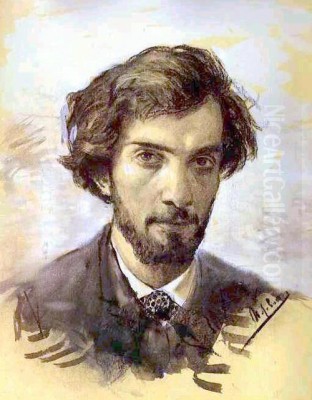
Isaak Ilyich Levitan stands as one of the most profound and influential figures in the history of Russian art. A landscape painter of extraordinary sensitivity, he transcended mere representation to capture the very soul of the Russian countryside. His work, often categorized as the "Mood Landscape" or "Lyrical Landscape," is characterized by its deep emotional resonance, poetic atmosphere, and subtle exploration of the interplay between nature and the human spirit. Despite a life marked by hardship and cut short by illness, Levitan created a legacy that continues to define the essence of Russian landscape painting.
Early Life and Artistic Awakening
Isaak Levitan was born on August 30 (August 18, Old Style), 1860, in the small town of Kibarty, near Kaunas in what was then the Augustów Governorate of the Russian Empire (modern-day Lithuania). He came from an impoverished but educated Jewish family. His father, Elyashiv Levitan, worked variously as a teacher of languages and reportedly as a translator for a French construction company involved in railway building, striving to provide for his family against the backdrop of societal limitations imposed on Jews within the Empire. Seeking better prospects, the family moved to Moscow around 1870.
Life in Moscow remained a struggle. Poverty was a constant companion, and the family faced the pervasive anti-Semitism of the era. Despite these challenges, young Isaak's artistic talent became evident. In 1873, at the age of thirteen, he gained admission to the prestigious Moscow School of Painting, Sculpture and Architecture. This marked a pivotal moment, placing him under the tutelage of some of Russia's leading artists.
His time at the Moscow School was formative. He studied initially under the stern realist Vasily Perov, a prominent figure among the Peredvizhniki (the Wanderers, or Itinerants). However, the most significant influences came later. Alexei Savrasov, himself a master of the lyrical landscape, recognized Levitan's potential and instilled in him a deep appreciation for the quiet beauty and emotional depth of the Russian countryside. Savrasov's famous painting, The Rooks Have Returned, exemplified the kind of poetic realism that would resonate with Levitan.
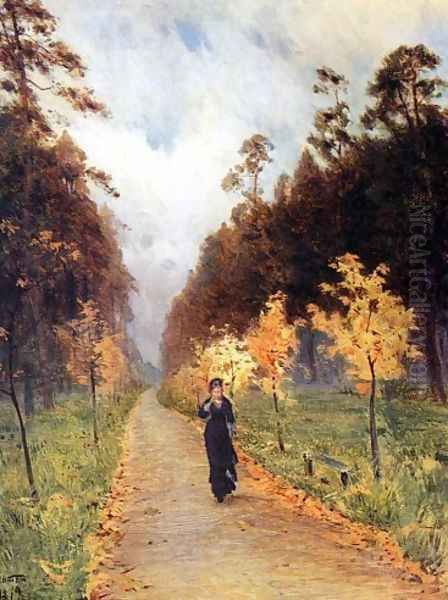
Another crucial mentor was Vasily Polenov. Polenov, who had spent time in Europe and was more attuned to contemporary trends like plein-air painting, encouraged Levitan to work outdoors and pay close attention to the effects of light and atmosphere. Polenov's own landscapes possessed a brighter palette and a more direct engagement with natural light, offering a counterpoint to the sometimes somber tones of earlier Russian realism. Levitan absorbed these lessons, blending Savrasov's lyricism with Polenov's emphasis on light and direct observation.
Even during his studies, Levitan faced adversity. The death of his mother, followed shortly by his father's serious illness and subsequent death, left him and his siblings destitute. He experienced periods of homelessness and extreme poverty. Furthermore, anti-Semitic decrees periodically led to the expulsion of Jews from Moscow. In 1879, following an assassination attempt on Tsar Alexander II, Levitan was briefly forced to leave the city, relocating to the nearby suburb of Saltykovka. These experiences undoubtedly contributed to the melancholic undercurrent present in much of his work.
The Emergence of a Style: Sokolniki and Early Recognition
Despite the hardships, Levitan's talent shone through. His student works already displayed a remarkable sensitivity to nature's moods. A key early painting, Autumn Day. Sokolniki (1879), created during his time in Saltykovka, is often cited as a breakthrough. The painting depicts a lone female figure walking along a path in Moscow's Sokolniki Park on a grey autumn day. The melancholic atmosphere, the muted colours, and the sense of quiet contemplation are hallmarks of his developing style. Interestingly, the figure was painted not by Levitan, who rarely included figures in his landscapes, but by his friend, the writer Nikolai Chekhov, brother of the famous playwright Anton Chekhov.
This early work already demonstrated Levitan's departure from purely topographical landscape painting. He was less interested in documenting specific locations than in conveying the emotional state evoked by a scene. The influence of his teacher Savrasov is palpable, yet Levitan's own distinct voice, characterized by a profound empathy for the landscape, was beginning to emerge.
His talent did not go unnoticed. Even as a student, his works attracted attention at exhibitions. The famed collector Pavel Tretyakov, founder of the Tretyakov Gallery, acquired some of Levitan's early paintings, providing crucial financial support and validation. This early recognition bolstered Levitan's confidence and allowed him to dedicate himself more fully to his art, despite his precarious financial situation and the societal obstacles he faced.
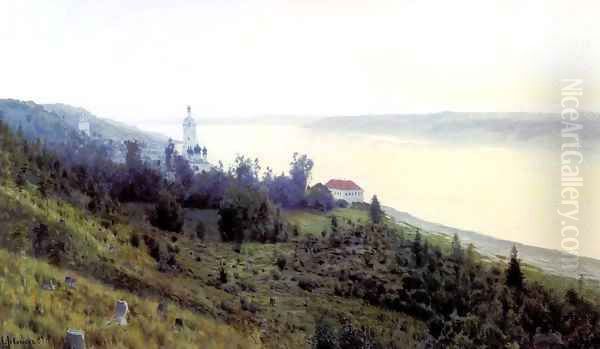
The influence of European art, particularly the French Barbizon School, also played a role in his development. Artists like Jean-Baptiste-Camille Corot, Charles-François Daubigny, and Théodore Rousseau, known for their atmospheric and emotionally resonant depictions of nature, shared a sensibility with Levitan. While he never slavishly imitated them, their focus on capturing the mood and poetry of the landscape resonated with his own artistic inclinations.
Travels and the Soul of the Russian Landscape
Levitan's art was deeply rooted in his direct experience of the Russian landscape. He travelled extensively throughout his relatively short life, seeking inspiration in the diverse scenery of central Russia, the Volga River region, the Crimea, and later even visiting Finland and other parts of Europe. These journeys were not mere sightseeing trips; they were pilgrimages in search of motifs that resonated with his inner world.
The Volga River held a particular fascination for him. He spent several summers in the town of Plyos on the Volga, a period considered exceptionally fruitful. The wide river, the rolling hills, the changing light, and the quiet provincial life provided endless inspiration. Works from this period, such as Evening. Golden Plyos (1889) and After the Rain. Plyos (1889), showcase his growing mastery of light and atmosphere, capturing the tranquil beauty and specific character of the region. Fresh Wind. Volga (1895), painted later but recalling these experiences, is a dynamic portrayal of the river under a breezy sky, full of movement and invigorating energy.
His travels also took him to the Crimea, where the southern light and landscape offered a different palette and mood. However, it was the landscape of central Russia – its forests, fields, rivers, lakes, and vast skies, often depicted in the transitional seasons of spring and autumn or the quiet moments of twilight – that remained the heartland of his artistic vision. He possessed an uncanny ability to capture the subtle nuances of the Russian climate and its effect on the land.
Paintings like March (1895) brilliantly evoke the specific feeling of early spring in Russia, with melting snow, dripping eaves, and the first hint of warmth under a bright blue sky. Golden Autumn (1895) is a radiant celebration of autumnal colours, yet imbued with a subtle poignancy, a sense of fleeting beauty typical of Levitan's work. These paintings demonstrate his profound connection to the cycles of nature and his ability to translate these observations into emotionally charged images.
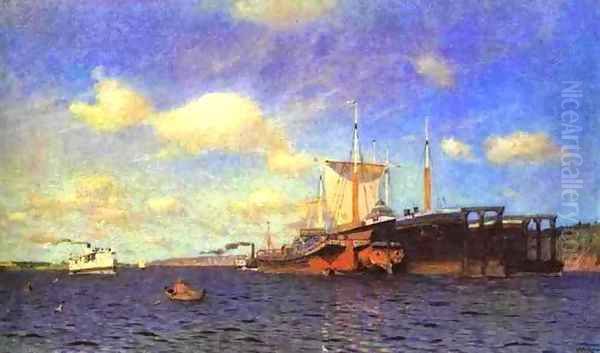
He often returned to specific motifs, exploring them under different conditions of light and weather. Birch groves, quiet rivers reflecting the sky, lonely country roads, and humble wooden churches became recurring themes, treated with deep affection and understanding. Through these seemingly simple subjects, Levitan explored universal themes of solitude, contemplation, the passage of time, and the enduring power of nature.
The Peredvizhniki and Artistic Circle
In 1891, Levitan became a member of the Society for Travelling Art Exhibitions (the Peredvizhniki or Wanderers). This group, which included many of the leading Russian artists of the time, such as Ilya Repin, Vasily Surikov, Ivan Kramskoi, and Levitan's former teacher Vasily Perov, aimed to break free from the constraints of the academic art establishment. They sought to create art that was more accessible to the public, often focusing on themes from Russian life, history, and landscape, imbued with a sense of social consciousness and national identity.
While Levitan shared the Peredvizhniki's commitment to realism and Russian themes, his focus remained intensely personal and lyrical. He was less concerned with narrative or social commentary than with exploring the emotional and spiritual dimensions of the landscape. Nevertheless, his association with the group provided him with exhibition opportunities and placed him firmly within the mainstream of progressive Russian art.
He maintained friendships and professional relationships with many prominent figures in the art world. Besides his teachers Savrasov and Polenov, he was close to artists like Valentin Serov, a brilliant portraitist and landscape painter in his own right, and Konstantin Korovin, whose style leaned more towards Russian Impressionism. He also knew Mikhail Nesterov, whose work often combined landscape with religious or spiritual themes, and the master of dramatic light effects, Arkhip Kuindzhi. Though perhaps less directly collaborative in the studio, Levitan's interactions with contemporaries like the great historical painter Vasily Surikov and the symbolist Mikhail Vrubel occurred within the shared context of the Moscow art scene and the Peredvizhniki exhibitions.
These connections fostered an environment of artistic exchange, even if Levitan's path remained uniquely his own. He absorbed influences, particularly Polenov's and Korovin's interest in plein-air techniques and brighter palettes, but always filtered them through his own melancholic and introspective sensibility. His dedication to landscape painting was almost singular, setting him apart even within the diverse Peredvizhniki movement.
The Mood Landscape Perfected
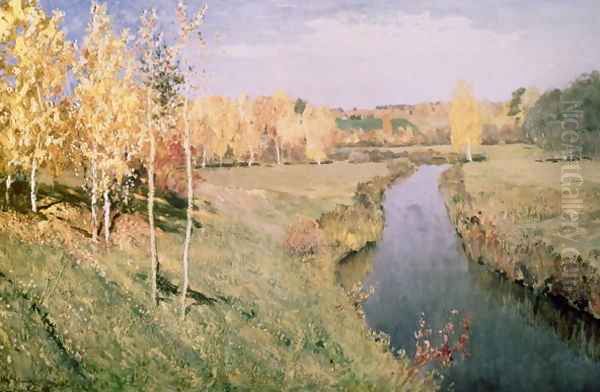
Levitan's mature style represents the culmination of the "Mood Landscape." This term aptly describes his ability to infuse depictions of nature with profound human emotion and psychological depth. His landscapes are rarely just picturesque views; they are meditations on the state of the soul, reflected in the natural world. He achieved this through a masterful command of composition, colour, light, and brushwork.
His compositions are often simple but highly effective, using elements like winding roads, solitary trees, or vast expanses of water and sky to create a specific emotional effect. He frequently employed low horizons to emphasize the immensity of the sky, a recurring feature that contributes to the sense of space and contemplation in his work.
Colour and light were crucial tools for conveying mood. While capable of capturing the brilliance of a sunny day as in Golden Autumn, Levitan often excelled in depicting the more subtle effects of twilight, mist, or overcast skies. His palette could range from the vibrant hues of autumn to the delicate greys and blues of a quiet evening or the stark whites and blues of winter. He understood how different light conditions could evoke feelings of joy, sadness, peace, or unease.
Works like Evening Bells (1892) exemplify this mastery. The painting depicts a monastery complex reflected in the still waters of a river at sunset. The warm glow of the setting sun, the tranquil water, and the distant sound of bells suggested by the title combine to create an atmosphere of profound peace and spirituality. It speaks to a longing for harmony and refuge, a common theme in his art.
Another masterpiece, Vladimirka Road (1892), carries a heavier emotional weight. It depicts the infamous road along which prisoners were marched on foot to exile in Siberia. The vast, empty landscape under a brooding sky, the endless road stretching towards the horizon, and a solitary wayside shrine evoke feelings of sorrow, oppression, and the immense suffering associated with the place. It is a landscape imbued with historical and social resonance, yet expressed through purely natural elements.
Levitan's technique evolved throughout his career. While always grounded in realism, his later brushwork often became looser and more expressive, suggesting influences from Impressionism without fully adopting its principles. He remained focused on the emotional content and the underlying structure of the landscape, rather than the purely optical effects of light that preoccupied many French Impressionists like Claude Monet.
Friendship with Anton Chekhov
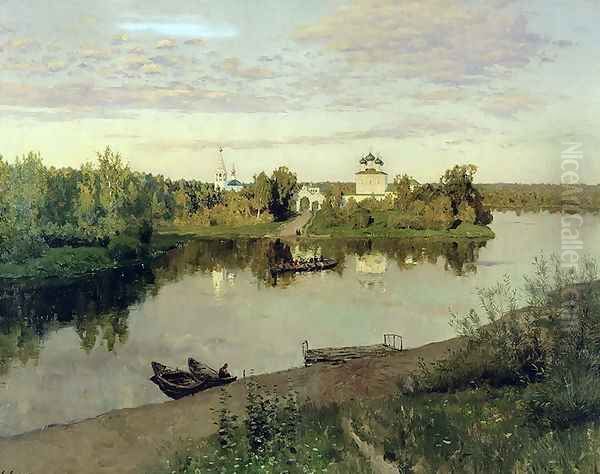
One of the most significant relationships in Levitan's life was his deep and complex friendship with the writer Anton Chekhov. They met in the early 1880s, likely through Chekhov's brother Nikolai, and quickly developed a strong bond based on shared artistic sensibilities and a mutual love for the Russian countryside. Both men possessed a keen sensitivity to the nuances of human emotion and a tendency towards melancholy, which found expression in their respective arts.
Their friendship was mutually influential. Chekhov admired Levitan's ability to capture the subtle poetry of nature, while Levitan found resonance in Chekhov's poignant portrayals of Russian life. They often spent time together in the countryside, and their correspondence reveals a deep intellectual and emotional connection. Chekhov's descriptions of nature in his stories and plays often echo the moods found in Levitan's paintings.
The relationship was not without its difficulties. A famous incident occurred when Chekhov published his story The Grasshopper (Poprygunya) in 1892. The story depicted a frivolous woman, her unassuming doctor husband, and her affair with a landscape painter. Levitan and his circle believed the characters were based on himself, his mistress Sofia Kuvshinnikova (also an artist), and her husband Dr. Dmitri Kuvshinnikov. Levitan felt betrayed and caricatured, leading to a temporary but bitter estrangement from Chekhov, during which Levitan reportedly challenged the writer to a duel (which never took place). They eventually reconciled, but the incident highlighted the intensity and sometimes fraught nature of their bond.
Despite this episode, their friendship endured. Chekhov's play The Seagull (1896), with its themes of artistic ambition, unrequited love, and disillusionment set against a lakeside estate, seems to capture something of the atmosphere surrounding Levitan and his circle. Levitan himself designed the scenery for the play's initial, unsuccessful production at the Alexandrinsky Theatre in St. Petersburg. The deep connection between these two giants of Russian culture remains a fascinating aspect of their biographies.
Later Years, Symbolism, and Final Works
In his later years, Levitan's work took on an increasingly philosophical and symbolic dimension. While still grounded in the observation of nature, his landscapes often seemed to grapple with profound questions of life, death, and eternity. His health, never robust, began to seriously decline due to a severe heart condition. This awareness of his own mortality likely contributed to the deepening introspection in his art.
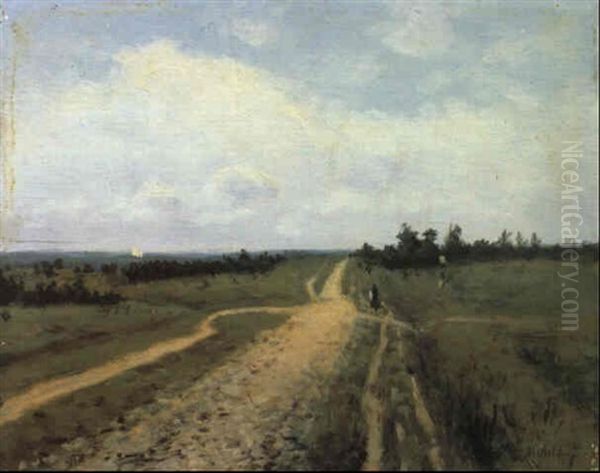
Above Eternal Rest (1894) is perhaps the most powerful example of this late style. It presents a dramatic vista: a small wooden church and a graveyard perched precariously on a high bluff overlooking a vast, stormy lake under an immense, turbulent sky. The painting evokes a sense of human fragility and solitude in the face of the overwhelming power and indifference of nature and eternity. It is a deeply moving meditation on existence, rendered with epic scale and emotional intensity.
Despite his failing health, Levitan continued to work tirelessly. He was elected to the Imperial Academy of Arts in 1898 and appointed head of the landscape painting studio at the Moscow School where he had once been a student, succeeding his mentor Polenov. He was a dedicated teacher, influencing younger artists like Isaac Brodsky.
His final major work, Lake. Rus' (or simply The Lake), remained unfinished on his easel at the time of his death. This large canvas depicts a serene, expansive view of a lake under a vast summer sky, dotted with clouds. It seems to represent a final, peaceful summation of his lifelong engagement with the Russian landscape, a vision of harmony and light contrasting with the turbulence of Above Eternal Rest.
Isaak Levitan died in Moscow on August 4 (July 22, Old Style), 1900, just shy of his fortieth birthday. His premature death cut short a brilliant career, yet he left behind an extraordinary body of work, estimated at over a thousand paintings, pastels, and drawings.
Legacy and Influence
Isaak Levitan's legacy is immense. He is universally regarded as one of Russia's greatest painters and the supreme master of the Russian landscape. He elevated landscape painting from mere depiction to a profound exploration of national identity, human emotion, and spiritual longing. His "Mood Landscapes" captured the unique character and soul of the Russian countryside in a way that resonated deeply with his contemporaries and continues to move audiences today.
His influence on subsequent generations of Russian landscape painters was significant. While few could match his unique blend of lyricism and depth, his work set a standard and opened up new possibilities for expressing emotion through nature. Artists associated with the Symbolist movement and later developments in Russian art drew inspiration from his evocative use of landscape.
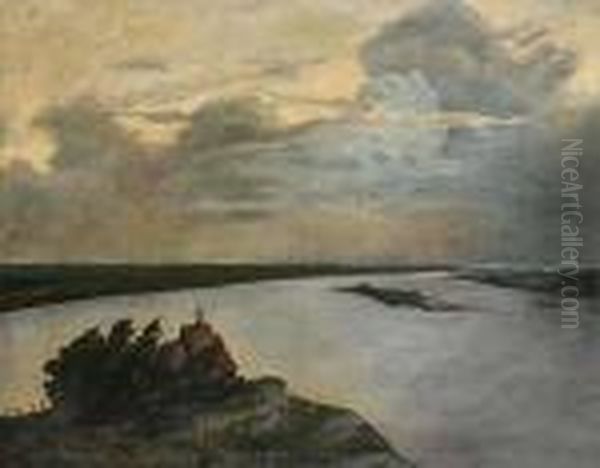
Today, his works are treasures of Russian art, housed primarily in the State Tretyakov Gallery in Moscow and the State Russian Museum in St. Petersburg. His paintings remain incredibly popular, admired for their technical mastery, their emotional honesty, and their timeless portrayal of the Russian land. He stands alongside other giants of Russian landscape like Ivan Shishkin, known for his detailed forest scenes, and Arkhip Kuindzhi, famed for his dramatic light, yet Levitan's contribution remains distinct in its profound emotional depth.
Conclusion
Isaak Levitan's art transcends the boundaries of time and place. Through his sensitive observation and poetic interpretation, he revealed the soul hidden within the Russian landscape. His paintings are more than just views; they are invitations to contemplate the beauty, melancholy, and enduring spirit of nature and its connection to the human heart. Facing poverty, discrimination, and ill health, he poured his life experience into his art, creating landscapes that speak of solitude, peace, sorrow, and the quiet majesty of the natural world. As the "master of the mood landscape," Isaak Levitan secured his place as an essential figure in Russian culture and a landscape painter of universal significance.